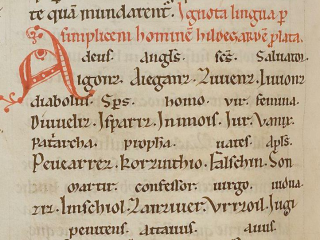Course Description
This course explores languages that have been deliberately constructed, including Esperanto, Klingon, and Tolkien’s Elvish. Students construct their own languages while considering the basic linguistic characteristics of various languages of the world. Through regular assignments, students describe the phonology, …
This course explores languages that have been deliberately constructed, including Esperanto, Klingon, and Tolkien’s Elvish. Students construct their own languages while considering the basic linguistic characteristics of various languages of the world. Through regular assignments, students describe the phonology, morphology, syntax, semantics, and writing system of their constructed language. The final assignment is a grammatical description of the new language.
Course Info
Instructor
Departments
Learning Resource Types
notes
Lecture Notes
assignment
Activity Assignments

The beginning of the Latin glossary for “Lingua Ignota,” an artificial language constructed in the 12th century by Hildegard of Bingen, a German abbess, writer, composer, and mystic. (Public domain image courtesy of Hochschul- und Landesbibliothek RheinMain.)








